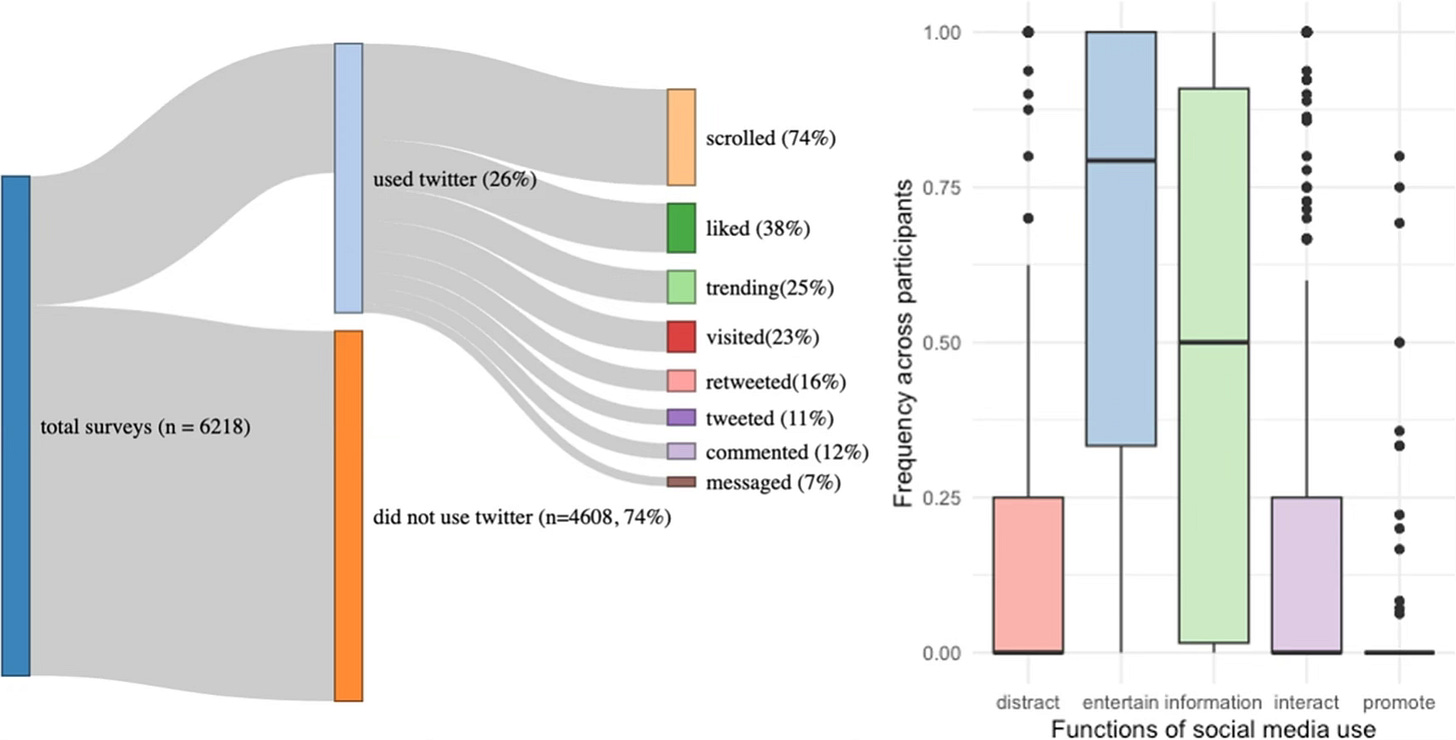Sadder, more polarised or one of the crowd?
Plus OpenAI hits back at the NY Times, Gemini and the rest
When writing Social Warming, one thing that continually encouraged me was how much scientific research there was that backed up my hypothesis. Cass Sunstein’s 1990s research on how groups selected for their agreement on a particular topic become more polarised around that topic, for example. A study of US Facebook users around the 2018 midterm elections, where they were paid to stay off it, and reported themselves to be happier as a result. There was tons of it.
But scientists are never satisfied, and recently another study was published, looking specifically at eX-Twitter—though the researchers prefer to call it “Twitter (X)”, which is probably describes better how people tend to think of it. The title sums it up, as it should: Twitter (X) use predicts substantial changes in well-being, polarization, sense of belonging, and outrage.
The work is done by a trio from the University of Ontario in Canada (Victoria Oldemburgo de Mello, Felix Cheung and Michael Inzlicht). The study is not large, but was intense: 252 participants were queried five times per day for a week.
I have to say that I love the first sentence of the introduction:
Social media has become so widespread that even if it had only a small impact on people, it could produce meaningful changes in society.
Which is, in case you haven’t read it, the core thesis of Social Warming, the book/phenomenon. Regrettably, they don’t cite my book anywhere, but that’s probably because I don’t style myself as Arthur, C., so my work wouldn’t fit into academic publishing.
The authors go on to point out that there hasn’t been very much close examination of the effects of Twitter on its users (the links are to the papers referenced):
Most Twitter research examines how public data, such as tweets and followings, relate to political polarization2,3, expressions of outrage4,5, and subjective well-being6. Nevertheless, public Twitter data does not reliably represent users’ thoughts: 80% of the tweets on the platform were produced by 10% of the users, who tend to be more engaged with and tweet more about politics than the average user, who tends to be younger, richer, more educated, and more engaged with politics than the average U.S. adult7,8. Thus, it remains unclear whether these findings generalize to most social media users or even most Twitter users.
The data was collected from a group of 309 participants between March and June 2021, so before the takeover of Twitter; however 57 were excluded for failing “attention checks” (ie didn’t respond to the researchers). They were picked to roughly match the demographic composition of the US population, both by sex and race.
What was different about this study was that the researchers asked a new question: could the effect on you of using a social network be related to what you’re using it for?
By looking at how people were using Twitter (just doomscrolling, or replying, or posting new content) and why they were using it—to find out something, or just for fun, or to engage with friends—the researchers got a picture of the effects that those three different modes of use created.
As you’d expect, most people just (doom)scrolled: this was nearly three-quarters of use. Then there was Liking, looking at Trends, following links (“visited” on the graphic), retweeting, actually tweeting fresh content, commenting (ie replying), and messaging. It’s set out in the graphic below, which is © Springer:
The numbers don’t add up to 100% (it’s 206%) because people did more than one activity, as you’d expect.
What is really interesting is how the research subjects’ intended use of Twitter—the “why are you here”—changed the effect it had on them. The scientists divided this “why” into five groups, and broke down how people spent their time on each activity: entertainment (66%), information seeking (49%), interacting with others (23%), escapism (18%) and self-promotion (only 2%, thankfully, though possibly a lot higher now). Again, this adds up to more than 100% (it’s 158%) because people would do more than one at a time.
The paper’s findings are not easy to disentangle, because when people use Twitter for multiple purposes, in multiple ways, it’s always going to be a struggle to figure out what caused what.
But the researchers seemed confident that they found the following:
using Twitter was associated to feeling worse about yourself, becoming more politically polarised1, feeling more outraged, but also a stronger sense of belonging.
(doom)scrolling for distraction made people gloomier
connecting to other people by replying, looking at Trends or profiles gave users a sense of belonging
looking for “entertainment” (not films, more like “Twitter fights”: the box on the sampling survey gave “to entertain myself/have fun”, which seems more like looking for beefs than the latest superhero trailer) was linked to increased polarisation
looking for information (on a topic) was linked to increased outrage.
In terms of personality:
people who used Twitter a lot were lonelier and more bored;
people who retweeted a lot were more polarized;
people who used Twitter to avoid their problems (escapism) had lower well-being and higher outrage levels; and
people who used Twitter for social interactions had a higher sense of belonging.
This is all fascinating.
Belonging: The surprising part, to me, is the “sense of belonging” finding—that people who connected there gained a feeling of being part of a community. This is actually very encouraging, but I think anyone who has used Twitter for any length of time in that way will be familiar with the feeling that there are certain people and personalities they’ve grown to know, and that when they see them tweeting there and interact with them, they get a sense of place. It’s certainly part of the ineluctable feeling one gets with post-Musk Twitter that the community feeling is missing: many people have dispersed to other places and so that familiarity is much harder to generate.
Polarising: Retweeting and “entertainment” (read: beefs) as paths to polarisation is also intriguing. You can think of an explanation for the retweeting one: that’s it’s the minimal effort for maximal return over something, and politics of course is a great source of polarity, so to speak, especially in the US. But what about the funseekers? My suggestion is that such people will almost inevitably find some sort of political content causing “fun”. Politics, after all, tries to expand to fill every space possible, and—vide Sunstein above—will push people towards extremes.
Outraging: why would escapists and/or information seekers become outraged by the content they find? For the escapists, it’s not surprising: the algorithm is going to feed you “engaging” content, and we know that that is the stuff most likely to fuel outrage, because it gets people to engage.
But the information seekers? Trickier. My guess would be that in the process of looking for whatever they’re after, they come across something “engaging”. It’s not very clear, from the experiment design, quite how focussed the information seekers are, but come on, this is Twitter, not Google Search.
But look, the study tells us things that we might have guessed; except it confirms them, and adds a little extra, in the form of the “belonging” part. Though it still says that doomscrolling will bring you down, and most other activities will make you polarised and outraged.
Still, mustn’t grumble, eh?
Glimpses of the AI tsunami
(Of the what? Read here. And then the update.)
• OpenAI accuses the New York Times of “hacking” to produce its lawsuit. Quite the retort in this lawsuit, which I think will run and run until suddenly it’s settled out of court with lots of money exchanged in both directions for access to each other’s products.
• Google shuts down its Gemini image generator; Sundar Pichai, the CEO, sends out a sua culpa memo expressing his discontent.
• Laurie Anderson has got a chatbot based on her late husband, Lou Reed. (You knew they were an item, yes?) She describes herself as “sadly addicted” to it—with a smile on her face.
• There’s a fascinating episode of the podcast series The Rest Is Entertainment (hosts: Marina Hyde and Richard Osman) (YouTube link) in which they discuss the potential for AI to take over making films, TV, adverts and so on. Hyde is, besides a hilariously smart satire writer, a screenwriter; Osman has worked on the creation of multiple TV series. Their take on what AI is going to do to content is.. quite worrying. They’re also very well informed on the how. Recommended.
• You can buy Social Warming in paperback, hardback or ebook via One World Publications, or order it through your friendly local bookstore. Or listen to me read it on Audible.
You could also sign up for The Overspill, a daily list of links with short extracts and brief commentary on things I find interesting in tech, science, medicine, politics and any other topic that takes my fancy.
• Back next week! Or leave a comment here, or in the Substack chat, or Substack Notes, or write it in a letter and put it in a bottle so that The Police write a song about it after it falls through a wormhole and goes back in time.
This was measured by asking how the respondent felt about the Democrats and Republicans, and looking at how it had changed since the previous response.





Great work Charles and thanks as ever for making this along with the overspill.
In particular, this helped me reflect on my post Twitter sadness - which I’m thankfully less sad about now - the loss of community mainly.
I also must say that TRIE podcast is one of my favourite things in the week. I love how insightful those two are and the chemistry is fun. Whereas the News Agents has become more of a sigh when I see it arrive in the overcast app - it feels like it’s become much more obviously a post-BBC rebound grind whereas the combination of curiosity and insight on the Stewart/Campbell-Osman/Hyde podcasts feel like it’s worth turning up because you’ll learn something positive and useful.
Anyways… as you were.